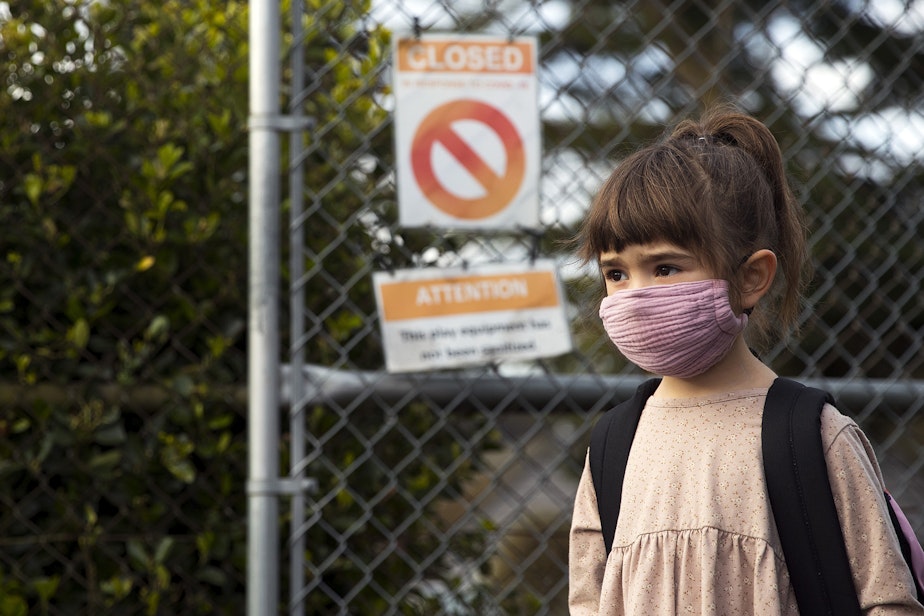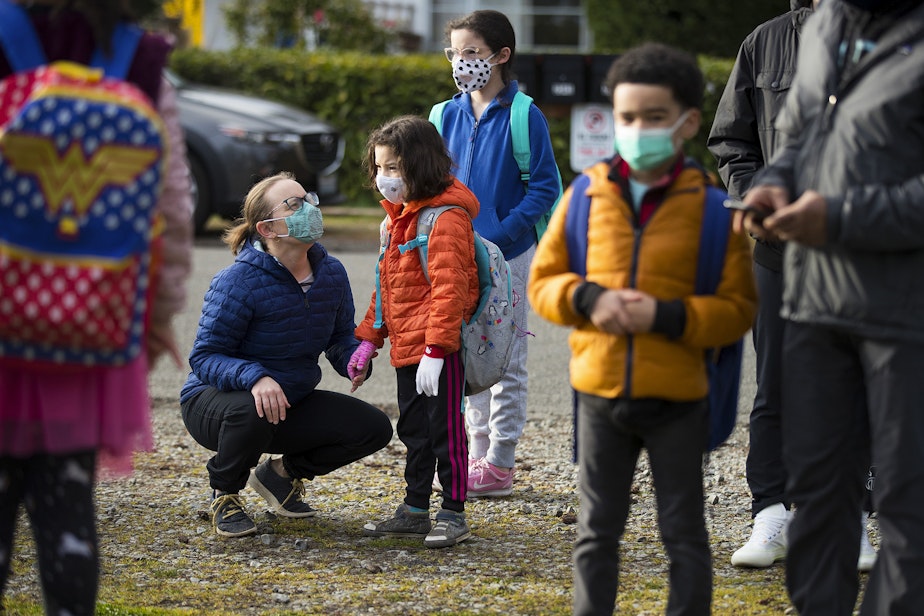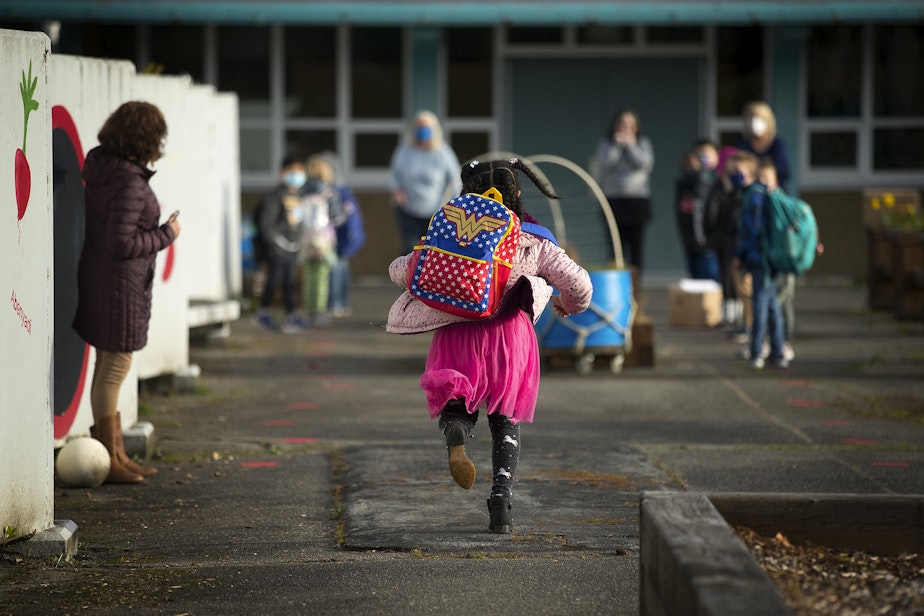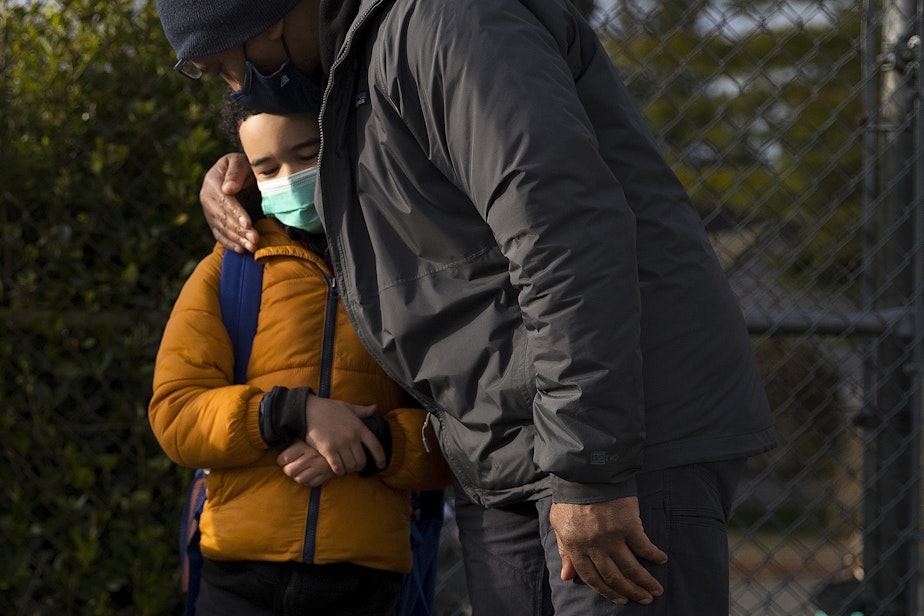'Kind of excited, kind of nervous.' Seattle elementary students return to the classroom
Monday was a landmark day in Seattle Public Schools as many elementary students, as well as some older students with disabilities, returned to school buildings for the first time in more than a year.
At 7:45 a.m., Theo Strange waited with his mother Katy outside Rising Star Elementary in Beacon Hill to see the inside of his kindergarten classroom for the very first time.
Theo said he felt “kind of excited and kind of nervous.” He said he was most eager about the first recess of his academic career and the prospect of playing with some toys at choice time.
On the other side of town, waiting to check-in for class outside Northgate Elementary School, fellow kindergartener Rooney Walkingstick shared similar sentiments.
"I'm a little scared and a little excited,” Walkingstick said, standing in line with her mother Ashley Walkingstick. At a check-in table school staff gave her a bright pink sticker with her name, classroom, and grade on it.

Mason Butler, a first grade student, said he had mixed emotions about his return to school. But attending class online didn’t lend itself to making friends, something Butler said he was good at.
At Rising Star, Theo’s mom, Katy Strange, was among the PTA volunteers holding cheerfully-decorated welcome signs for families as they rolled up along the curb to drop off their students — staying inside the car, as instructed.
Sponsored
Strange said this seemed like a good time to send her two elementary students back to buildings.
“We're at the point where a lot of our vulnerable family members are vaccinated, so we're feeling more comfortable. The [school] staff is vaccinated, so we're feeling like it was safe to come back,” Strange said.
In a district survey in March, 58% of respondents, with students eligible to return to the classroom — primarily in grades preK through 5 — said they planned to attend school in-person. The willingness and ability to return to in-person learning varies widely across the district, with apparent demographic trends.
Schools with primarily white and wealthier families report much higher in-person attendance than lower-income schools with students who are primarily Black, Indigenous, and people of color.

At Rising Star, for instance, Principal Huyen Lam said about 30% of students are expected in-person. She said some are unable to attend due to a lack of district transportation — after school bus contractor First Student laid off drivers in the fall. At present, the district is offering transportation only for students legally entitled to it, including students facing homelessness and those with disabilities.
Sponsored
“The bus logistics have been crazy,” Lam said. “We are putting placeholders in for families who don’t have transportation. Things happen, but we’ll find ways to help our kids.”
One PTA member waving welcome signs, Qiulian Lai, said her two children, who are in third and seventh grade respectively, will be staying remote because it works well for them.
Her son, an introverted seventh grader, likes to be able to play video games with the free time he gains from not having to commute to school, she said. Her daughter, who is in third grade at Rising Star, “loves the small groups” in online learning at the school, and wants to stay in those groups by remaining all-remote.
Lai said she was glad to be at the school to welcome back families who prefer in-person learning for their kids — like a mom who had moved to the United States from China just two months before schools closed.
For the past year, through remote learning, “her kid was very focused on [online] gaming,” Lai laughed. “She’s very happy the kids can come back to school.”

Students in grades K-5 and kids in special education intensive pathways — those who spend most or all of their time in self-contained classrooms — are back in a hybrid model, with students in cohorts of 15 or fewer and attending either morning or afternoon, 2 hours and 45 minutes a day, four days a week.
The cohort model is one of the many steps the district is taking to prevent the spread of the coronavirus.
Monday was the second of three major phases of reopening Seattle Public Schools. Preschool students and some elementary students who receive intensive special education services were invited back to buildings one week ago.
Governor Jay Inslee ordered districts to offer in-person instruction at least 30% of the time, and for a minimum of two days per week, to elementary students by April 5, and to middle and high school students by April 19.
A tentative agreement the district and its teachers union reached last week would bring middle and high school students back on that deadline, also in a hybrid model. That plan would allow students to return in-person two afternoons per week.

In elementary schools on Monday, after the morning cohort went home at 10:45, teachers had lunch breaks and got the classrooms clean and ready for the afternoon groups.
At 11:45 a.m. at Magnolia Elementary School, masked-up students lined up outside as parents took photos and captured video of their childrens’ return to in-person class, after spending more than a year at home.
There were screams of joy, as students were reunited with teachers. Tamra Wynn said she was overjoyed about her child’s return to school and wasn’t worried — even with a recent increase of Coronavirus cases in King County.
“I don't feel concerned,” Wynn said. “I feel like we've been really cautious and careful, and following Governor Inslee’s protocols throughout this whole long process. And so I'm confident that this is going to be a positive adjustment.”






